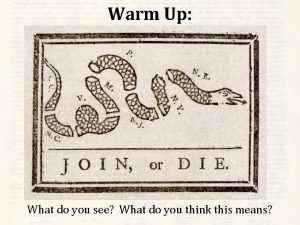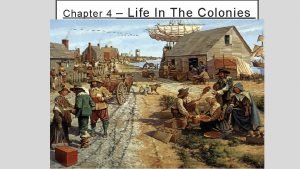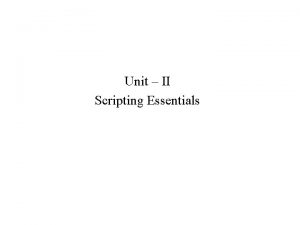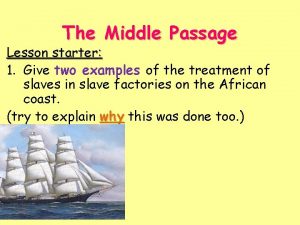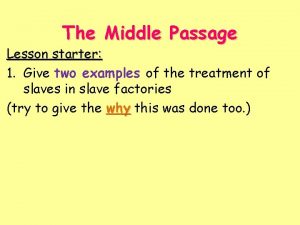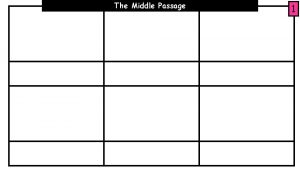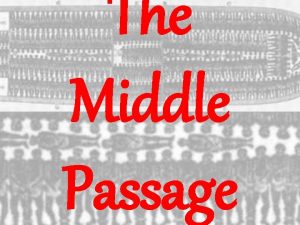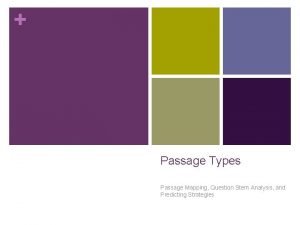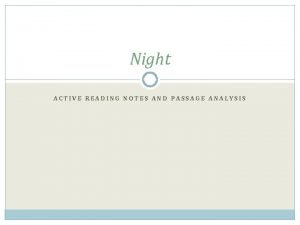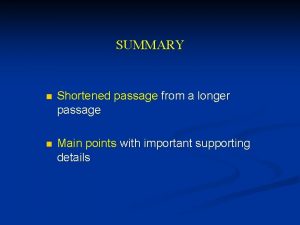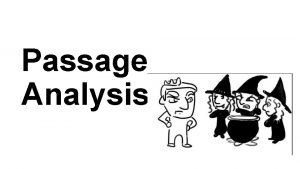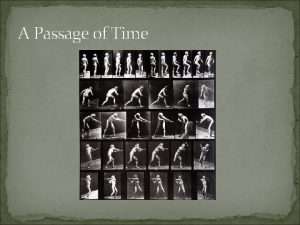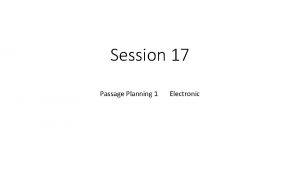The Middle Passage Lesson starter 1 Give two










































- Slides: 42

The Middle Passage Lesson starter: 1. Give two examples of the treatment of slaves in slave factories on the African coast. (try to explain why this was done too. )

We are learning to… • Describe the conditions of the Middle Passage I can… • Write an account of an African on a slave ship • Complete example N 5 Qs

Background • The voyage from West Africa to the West Indies became known as the middle passage • It was the most brutal part of the slave trade • The conditions on the middle passage regularly come up in the N 5 paper!

Watch the clip and write down 5 things you notice • https: //www. youtube. com/watch? v=f. CHv. D 2 D y. We. Y • https: //www. youtube. com/watch? v=0 XNzm 6 Uf 6 wo

Stage 1: Boarding • Slaves were loaded like goods onto ships – quickly and efficiently • They were usually carried to slave ships on canoes • Nets were placed around the ship to stop slaves trying to escape or commit suicide • Heads were shaved and clothes removed • Some Africans believed they were going to be eaten by Europeans and were terrified



Stage 2: On Board • Slaves were kept below deck on the ship (no fresh air or light) • Slaves were chained together side by side • They were restrained using shackles (fastened ankles together) or manacles (wrists) • Slaves did the toilet in latrine buckets which were often knocked over in the dark or by choppy sea • The voyage took about 6 -8 weeks • They ate, slept, did the toilet, gave birth and died below deck • They had no idea where they were or where they were going • Many tried to commit suicide by jumping overboard




Middle Passage: Daily Routine • Slaves were usually allowed up on deck for 1 -2 hours a day for air and exercise (only when land was out of sight) • They were taken up in groups and kept chained together • They were fed twice a day (rice, millet, yams & sometimes oranges) and given about a pint of water • Slaves were made to clean the ship • Slaves were whipped to make them jump/ exercise/ move about

• Slaves whipped to make them exercise


Disease • The ship’s crew dreaded an outbreak of disease as it was very hard to contain on board • Common outbreaks were gastroenteritis, dysentry, dropsy, scarlet fever and yellow fever • During a storm, disease spread quickly as slaves were kept below deck in filthy conditions – hot, damp, no fresh air etc. • Often the crew would become ill too – deaths amongst crew on slave ships were much higher than on other boats • Working as crew was not a desirable job – many had to be bribed or plied with alcohol to agree to it

Rebellion on the Middle Passage • Attempts by the slaves to take over were very common but rarely successful • There was roughly eight ‘insurrections’ for every 10 voyages • Over 50 major mutinies occurred on slave ships in the Middle Passage between 1699 and 1865. • The primary sources on the next slide tell us about some examples… Look for information on; • What the slaves arm themselves with • How successful rebellions were

I discovered today that the slaves were plotting an insurrection. I found some knives, stones and a chisel. I put four boys in irons and thumbscrews to urge them into a confession. From Captain John Newton’s diary. The Africans armed themselves with various weapons. They came in crowds on our men and attacked them unaware. The stabbed the stoutest one of us. He received 15 wounds. Next they assaulted the boatswain (supervisor) and cut one of his legs to the bone right through the nerve. Another cut the cook’s throat and threw a sailor overboard. This rebellion was immediately put down. Many of the mutineers leapt overboard and drowned themselves.

There were frequent uprisings but most were prevented. Some succeeded and killed the whole crew, but only a few. When the leaders of these were quizzed they asked us what business we had to take them from their country. That they had wives and children in Africa. In the latest insurrection, we lost 100 slaves who have jumped overboard. Most were recovered but three chose death rather than come back onboard.


Choice of Tasks – Middle Passage N 4 Task You should write a memoir for an African on the middle passage between Africa and the West Indies. You should include; ü Boarding the ship ü Conditions on board ü Daily Routine ü Disease ü Rebellions 6 marks available – 1 for every factually correct point. N 5 Question Describe conditions for slaves on board slave ships during the middle passage. 4 marks = 4 sentences each with a new detailed point.

2016 Q 1 How Fully – Middle Passage Judgement, source x 3, recall x 3

Judgement if no J, max 2 marks Source • Slaves tightly packed • Conditions horrendous and slaves denied basic sanitation • Disease common and many died from illnesses like dysentery • Food was given but it was unfamiliar and many refused to eat Recall • Slaves were chained together • Slaves were kept below deck with no fresh air or daylight • Slaves were danced and whipped up on deck • Women were abused by crew • Slaves fed millet and yams in their hands • Any other valid point

Specimen Paper Evaluate Usefulness

Slave Auctions Lesson starter 1. Describe how an auction works. 2. What type of slaves do you think would be most valuable? Why?

We are learning to… • Explain how a slave auction worked • I can… • Create a poster advertising a slave auction or • Write a description of a slave auction

Background • At the end of the middle passage the slaves would arrive in the West Indies/ America • They were sold by auction (to the highest bidder) • Those who were not sold were sold at a scramble – buyers rushed forward to grab the ‘lot’ they wanted to buy • Posters advertising slave auctions would go up as soon as ships arrived

Task One • Use the following sources to gather information • Write down 1 or 2 key points that you notice for each







Key points Slaves advertised as –’negroes’ Posters in English – English speaking buyers Young men most valuable Skills made slaves more valuable – carpenter etc • Sold at the same time as goods and tools • Described as ‘gangs’, ‘cargo’ - dehumanised • Given English names • •

Preparing the slaves for sale • It was important that slaves looked as healthy and fit as possible so they would fetch the highest prices • Slaves were; • Washed with water • Rubbed with palm oil • Wounds from the middle passage were filled up – with tar, gunpowder or rust • Slaves with grey hairs had their heads shaved • Slaves who were sick were treated brutally to hide signs of illness – tar was put inside their anus to hide diarrhoea for example

How the Slave auctions worked – in detail • In the auction, an auctioneer sold the slaves individually or in lots (as a group), with the slaves being sold to the highest bidder. • The other method was the scramble. Here the slaves were kept together in an enclosure. Buyers paid the captain a fixed sum beforehand. • Once all the buyers had paid, the enclosure gate was thrown open and the buyers rushed in together and grabbed the slaves they wanted. This was often a terrifying experience for the slaves. • Slaves left behind were called ‘refuse’. They were sold cheaply to anyone who would take them. • Any that couldn’t be sold were left at the coast to die





Clips • http: //www. bbc. co. uk/education/clips/zbttsbk • https: //www. youtube. com/watch? v=bfw 9 m. Lj h 7 YM

Task – Your choice Task One Task Two Create a poster which advertises a slave auction It should ü Show where & when the sale is ü What ‘lots’ are for sale ü The skills of each ‘lot’ ü Use language appropriate for the time period ü Be in the style of the 18 th century Write an eyewitness account of a slave auction It should ü Include a description of the ‘lots’ for sale ü Explain how the sale works ü Describe what happens to the slaves who are not sold ü Discuss how the slaves are treated during the auction
 Lesson starter
Lesson starter What is the main idea of give me liberty or give me death
What is the main idea of give me liberty or give me death What is included in new england
What is included in new england Middle passage definition
Middle passage definition Middle passage
Middle passage Lesson plan for notice writing
Lesson plan for notice writing Capulet threatens to disown juliet quote
Capulet threatens to disown juliet quote Give one or two examples of how maps can be misused.
Give one or two examples of how maps can be misused. Real life example of computer addiction
Real life example of computer addiction From the text give two reasons why languages are lost
From the text give two reasons why languages are lost Two examples of circular motion
Two examples of circular motion Lower part of the sewing machine
Lower part of the sewing machine Advantages and disadvantages of quarter sawing
Advantages and disadvantages of quarter sawing Scripting language examples
Scripting language examples Some examples of combination reaction
Some examples of combination reaction Hát kết hợp bộ gõ cơ thể
Hát kết hợp bộ gõ cơ thể Slidetodoc
Slidetodoc Bổ thể
Bổ thể Tỉ lệ cơ thể trẻ em
Tỉ lệ cơ thể trẻ em Voi kéo gỗ như thế nào
Voi kéo gỗ như thế nào Chụp phim tư thế worms-breton
Chụp phim tư thế worms-breton Chúa yêu trần thế
Chúa yêu trần thế Môn thể thao bắt đầu bằng chữ f
Môn thể thao bắt đầu bằng chữ f Thế nào là hệ số cao nhất
Thế nào là hệ số cao nhất Các châu lục và đại dương trên thế giới
Các châu lục và đại dương trên thế giới Công thức tiính động năng
Công thức tiính động năng Trời xanh đây là của chúng ta thể thơ
Trời xanh đây là của chúng ta thể thơ Mật thư tọa độ 5x5
Mật thư tọa độ 5x5 Phép trừ bù
Phép trừ bù Phản ứng thế ankan
Phản ứng thế ankan Các châu lục và đại dương trên thế giới
Các châu lục và đại dương trên thế giới Thơ thất ngôn tứ tuyệt đường luật
Thơ thất ngôn tứ tuyệt đường luật Quá trình desamine hóa có thể tạo ra
Quá trình desamine hóa có thể tạo ra Một số thể thơ truyền thống
Một số thể thơ truyền thống Bàn tay mà dây bẩn
Bàn tay mà dây bẩn Vẽ hình chiếu vuông góc của vật thể sau
Vẽ hình chiếu vuông góc của vật thể sau Nguyên nhân của sự mỏi cơ sinh 8
Nguyên nhân của sự mỏi cơ sinh 8 đặc điểm cơ thể của người tối cổ
đặc điểm cơ thể của người tối cổ Thứ tự các dấu thăng giáng ở hóa biểu
Thứ tự các dấu thăng giáng ở hóa biểu Vẽ hình chiếu đứng bằng cạnh của vật thể
Vẽ hình chiếu đứng bằng cạnh của vật thể Fecboak
Fecboak Thẻ vin
Thẻ vin đại từ thay thế
đại từ thay thế

